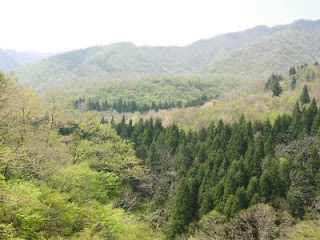

The torii is the gate through which one passes to enter a Shinto shrine. The Chinese characters for torii are 鳥 (tori), which means "bird", and 居 (i), which means "to dwell"; together the characters form the compound 鳥居 (torii). It is thought that the gateway was originally a perch for sacred fowl that announced the coming of day, rousing the Shinto faithful from their slumbers to salute the sunrise. This outdated custom recalls the Japanese belief that the "race" is descended from the Sun Goddess, Amaterasu. A communication sent by a 7th century Japanese potentate to his Chinese counterpart was signed "From the Emperor of the Land of the Rising Sun to the Emperor of the Land of the Setting Sun". The photos were taken at Yahiko Shrine, the largest in Niigata Prefecture. In August of 1689 Basho spent a night in Yahiko during his Oku-no-Hosomichi walking tour of northern Japan.





















